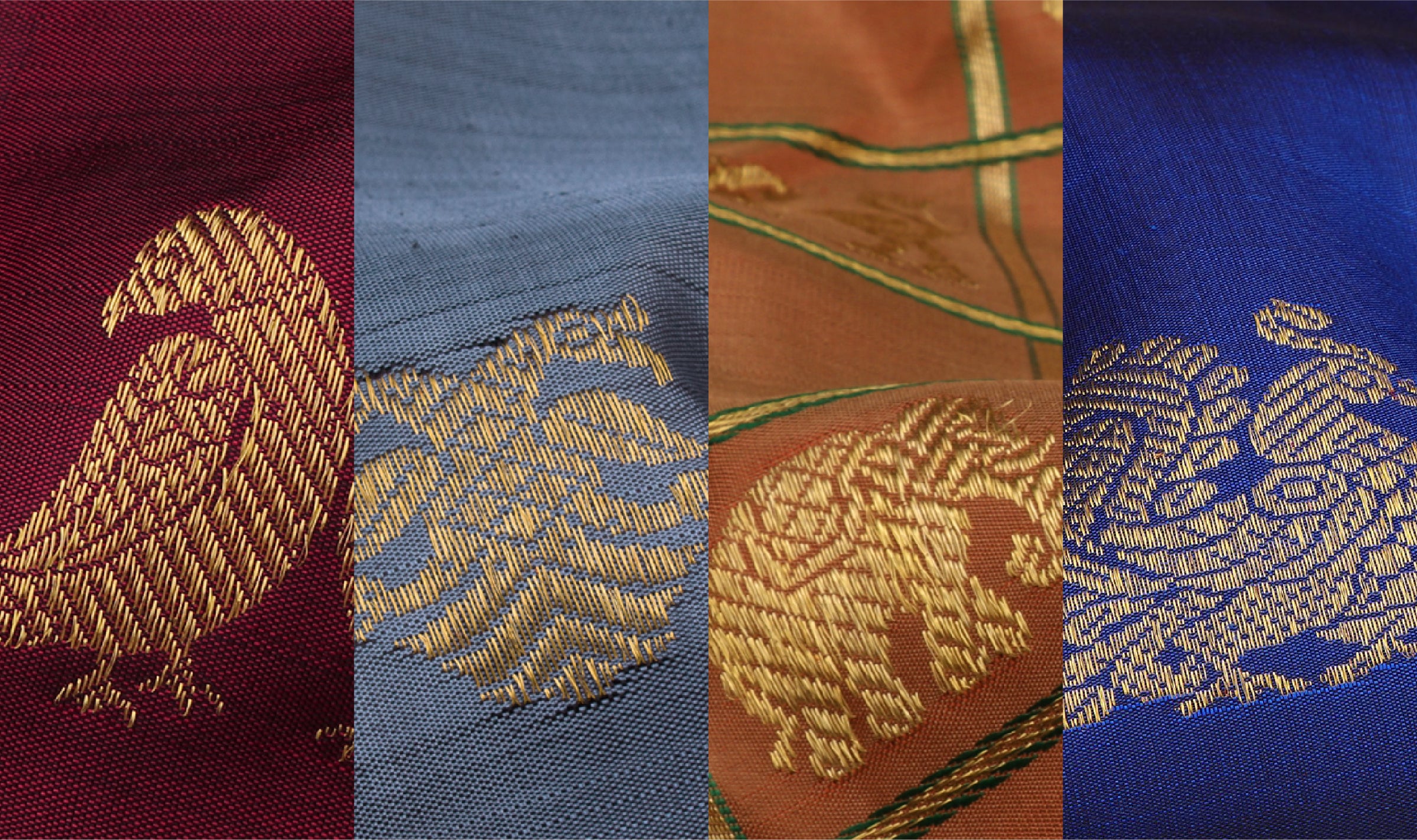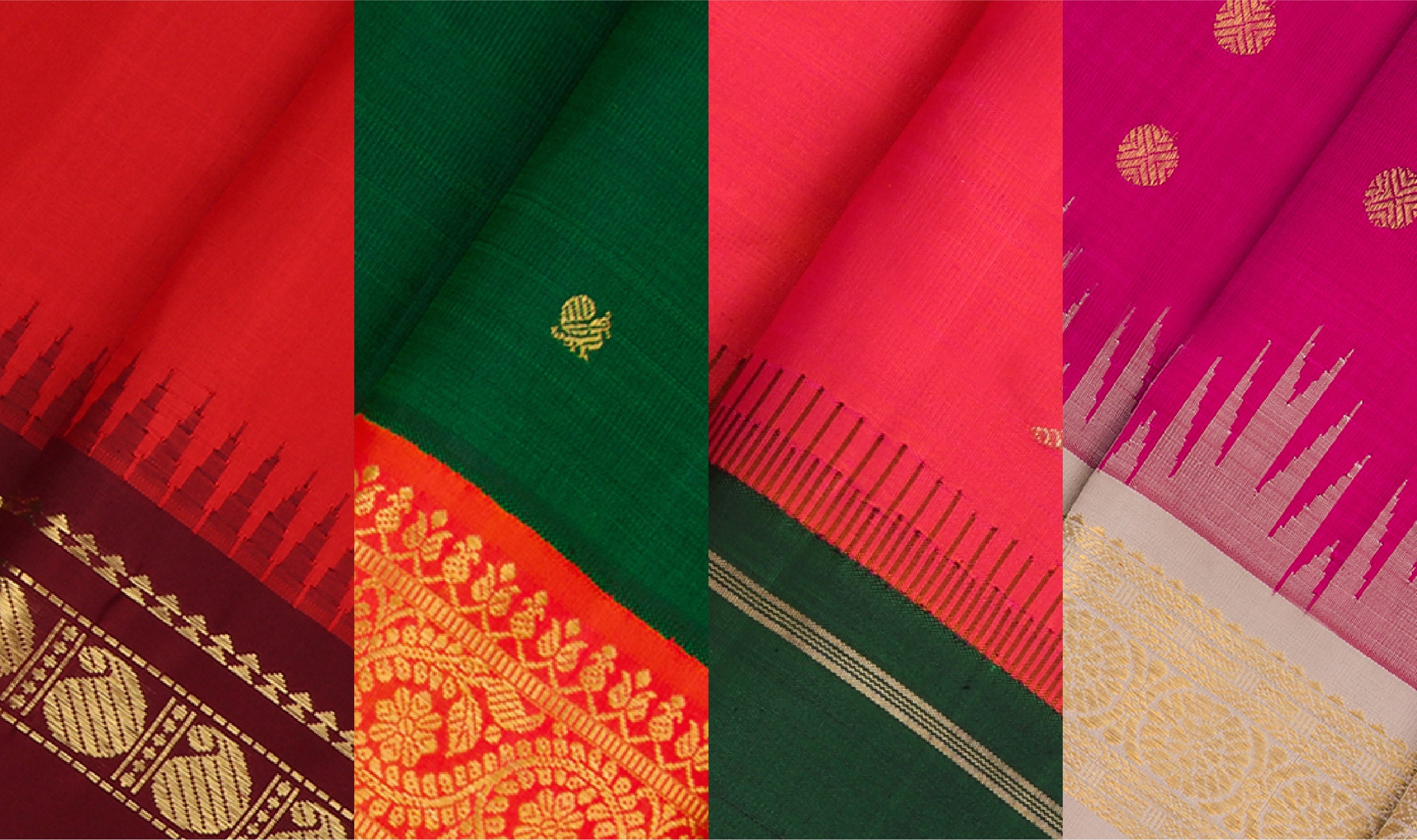Varna Sutra: Antar Anga - Checks & Stripes

In this edition of Varna Sutra we look at the patterns that make up the body of the sari, focusing on the kattam and vari (checks and stripes). The weavers of Tamil Nadu possess a skillful mastery over the weaving of checks and stripes. The result is a powerful geometric visual and emotive force of expression.
The simple concept of checks and stripes has been transformed by weavers in unique ways, infusing striking colours and flavours into the bold geometry of the drape. The Kattam Vari gives way to a million combinations, as a result of using different yarns and zari in both the warp and weft of the sari. In kanjivarams, the geometrical foundation of the layout and the mathematical precision in arranging the colours is the differentiating factor. Antar Anga (meaning within the body), focuses on these simple yet stunning designs in this weave.
Kattam means a defined space, which is enclosed, and has become associated with a sacred space. It is based on multiples of crosses, representing four directions and transforms into a magical grid. It is this grid which is drawn as “padi kolam” everyday by women in the households of South India, adorning the front of the main door to one’s home. The symbol created by astrologers as they draw an astrological chart is a reflection of this form as well. It is also the base of any architectural structure. The same symbol is woven into a pattern made for ritual clothes like telia rumal and saris worn by women.
The long rectangular form of the sari has always been clearly divided into three distinct parts – the body, the border and the pallu (or munthanai) with a distinct relationship between these three elements.
Muppagam

The ways in which a kanjivaram is divided into its body, borders and pallu emphasise the theatrical geometry of the kanjivaram. A perfect muppagam is created when the sari’s width is divided into three equal parts, with the upper and lower sections forming contrast borders.
Arai Pagam

When the width of a kanjivaram is divided into two—forming a perfect half—the layout is referred to as arai pagam. This geometry, which lends itself to the delightful play of colour, highlights the bold drama of the queen of silks.
The weavers of kanjivaram saris give shape to various sizes of checks in yards of fine silk fabric. In this edition of Varna Sutra, we take a look at the varied expressions of kattam and vari in the kanjivaram which have withstood the test of time.
Palum Pazhamum

Translating to “milk and fruit” checks, the traditional palum pazhamum combination is woven in the auspicious colours of red, yellow and green. This design became popular in 1961 when a movie by the same name was released with the famous actor duo Sivaji Ganesan and Saroja Devi. If you watch the movie, you might notice that neither of the leading heroines (Saroja Devi and Sowcar Janaki) actually wears this particular design in the film. Yet everyone associates this name with the super hit movie.
Kasa-Kasa Kattam

The Kasa-Kasa checks resemble tiny poppy seeds (kasa-kasa in Tamil). The checks are so delicate and fine that their beauty is visible only when the sari is draped.
Puliyam- Kottai Kattam

The two-toned sari with checks the size of tamarind seeds (puliyam kottai) – about an inch or less in size – patterned all over the body has an enduring charm. With checks in various combinations of colours, this sari, traditional to Tamil Nadu, has a distinct identity.
Interestingly, the tamarind and its seeds play a role in our everyday lives, rooted in South Indian culture. The seeds are used while playing “pallankuzhi’, which is a famous traditional board game in Tamil Nadu. Tamarind pulp is the basic ingredient for several South Indian delicacies like sambar, rasam and vatha kuzhambu.
Muthu Kattam

The tiny white squares of the muthu kattam resemble pearls, providing an additional texture to the design which is stunning. Usually the kattam is in white silk thread, contrasting beautifully with the deep hues of the body and making the sari all the more appealing.
Koorai Kattam

The perfect contrast kattams in the koorai pudavai with wide contrast borders are an evergreen classic in the kanjivaram tradition. A small village in Koorainadu of Tanjore district transcended its borders and earned a name for its vibrant checks woven in its coarse cottons. No wonder it influenced the entire state and found a way in to the silks woven by kanjivaram weavers too.
Kottadi Kattam

This pattern is quintessentially Tamil, and kottadi is used to refer to the single and fine checks woven on the silks, as well as the fine texture of zari kattams incorporated in the body of the sari. The delicate play of colours, contrasts and hints of metallic distinguishes this design.
Paimadi Kattam

Paimadi checks were inspired from the regional craft communities of South India. The unique tabby weave from basketry was common to various regions of Tamil Nadu. In a kanjivaram, it is featured as a simple criss-cross pattern within each check.
High Court Checks

The distinctive black and white floor tiles of the Madras High Court inspired the High Court papli checks on the kanjivaram sari, a celebration of the most classic colour combination.
Vazhaipoo Stripes

Referred to as aathi vazhai (plantain flowers) in Tamil, the linear lines of alternating colours run through the body of the sari. As we have seen, the elements of a kanjivaram’s design are inspired by the familiar, and weavers incorporated the beautiful layering of these flowers into the weave.
Thandavalam Stripes

Inspired by the parallel railway tracks, the thandavalam lines are thicker than aathi vazhai. These stripes are flanked by a line in a contrast colour to make the visual effect even more striking.
Veldhari Stripes

Woven on the warp of the sari, the wavy lines of veldhari with dots in between have been popular since time immemorial. One can see a resemblance between the border patterns of kolams drawn by the women folk of Tamil Nadu and this geometric design.
Vaira Oosi

The fine, needle-thin lines that run parallel to the border of a kanjivaram are called vaira oosi, literally translating to diamond needle. This delicate pattern that runs along the entire length of a sari is woven in rich zari. Interspersed with the colour of the kanjivaram’s body, the design lends glitter and lustre to the drape.
As we unravel the roots and origins of the woven yards of a kanjivaram, we are left in awe of the diverse styles of weaving, and the distinctive design vocabulary that form this drape.
- Sreemathy Mohan



